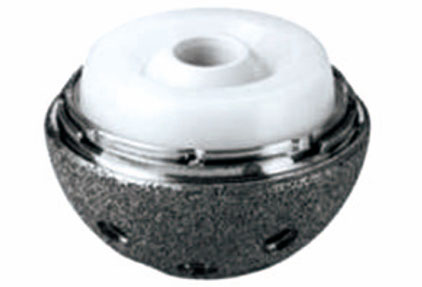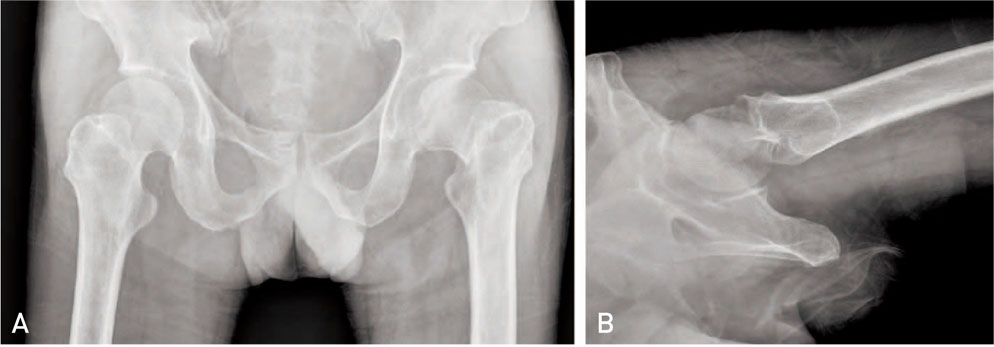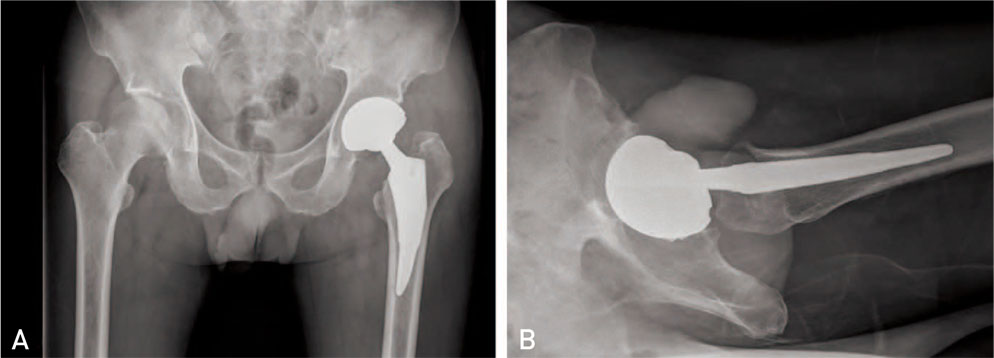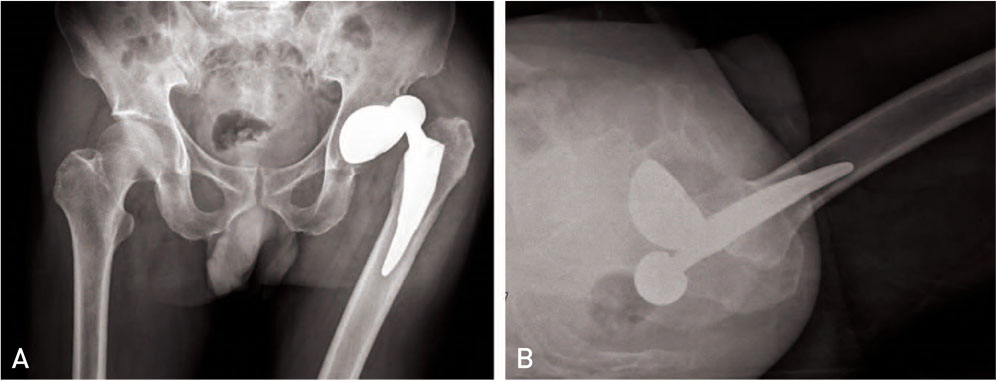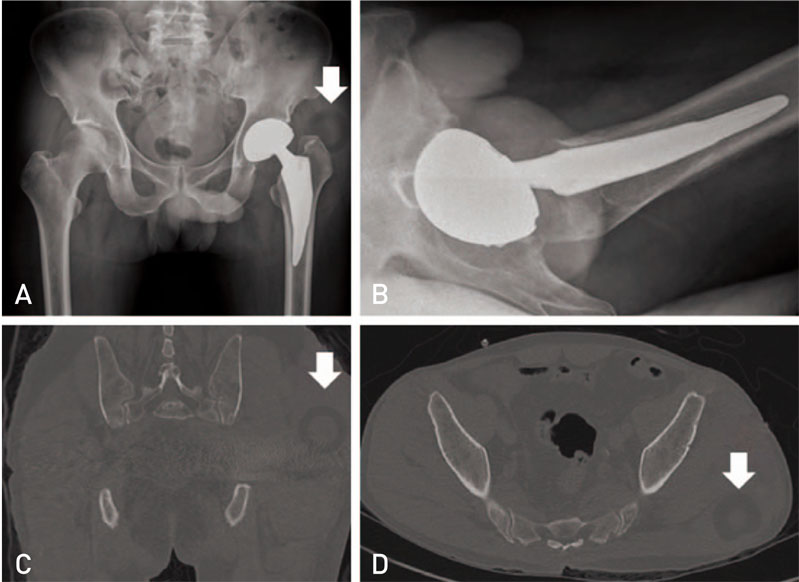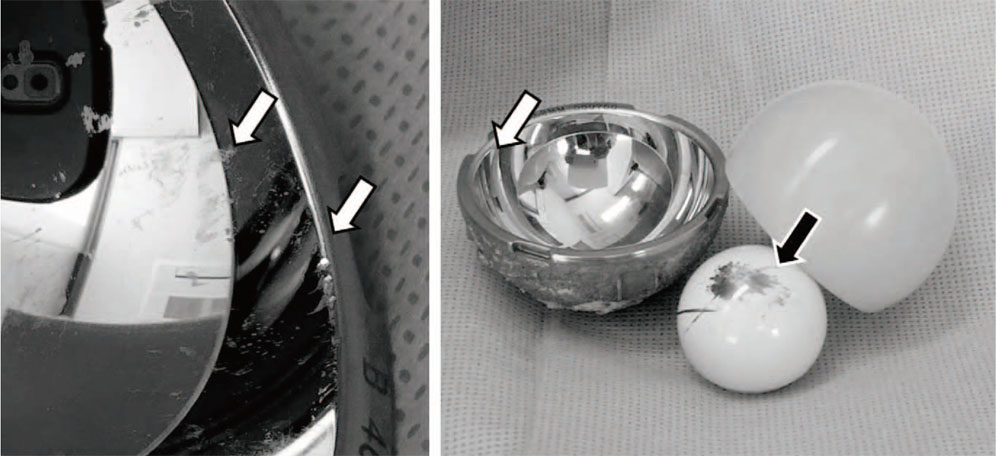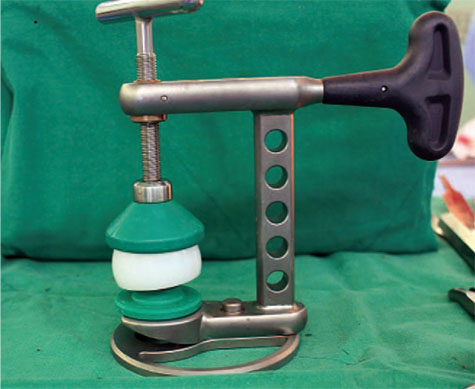Hip Pelvis.
2017 Jun;29(2):133-138. 10.5371/hp.2017.29.2.133.
Dissociation of Polyethylene Liner of the Dual Mobility Acetabular Component after Closed Reduction of Dislocation: A Case Report
- Affiliations
-
- 1Department of Orthopaedic Surgery, Kyung Hee University Hospital at Gangdong, Seoul, Korea. mozart13@khu.ac.kr
- 2Department of Orthopaedic Surgery, Kyung Hee University Hospital, Seoul, Korea.
- KMID: 2424242
- DOI: http://doi.org/10.5371/hp.2017.29.2.133
Abstract
- A dual mobility acetabular component has a structure that combines a polyethylene liner and a femoral head, unlike the general design of acetabular cups, making the dissociation of a polyethylene liner highly unlikely. In addition, it increases the range of motion and reduces the possibility of dislocations by increasing a jump distance. A fifty-one-year-old male who had received total hip arthroplasty with the dual mobility acetabular component visited a hospital for a posterior hip dislocation 10 weeks after the operation. At the emergency room, closed reduction was performed and the dislocation was reduced. However, plain imaging test revealed polyethylene liner dissociation after the closed reduction. Revision surgery was performed. We will report a rare case of early dislocation of the dual mobility acetabular component and dissociation of polyethylene liner accompanied with a literature review.
Keyword
MeSH Terms
Figure
Reference
-
1. Philippot R, Adam P, Reckhaus M, et al. Prevention of dislocation in total hip revision surgery using a dual mobility design. Orthop Traumatol Surg Res. 2009; 95:407–413.
Article2. Philippeau JM, Durand JM, Carret JP, Leclercq S, Waast D, Gouin F. Dual mobility design use in preventing total hip replacement dislocation following tumor resection. Orthop Traumatol Surg Res. 2010; 96:2–8.
Article3. Guyen O, Pibarot V, Vaz G, Chevillotte C, Béjui-Hugues J. Use of a dual mobility socket to manage total hip arthroplasty instability. Clin Orthop Relat Res. 2009; 467:465–472.
Article4. Philippot R, Camilleri JP, Boyer B, Adam P, Farizon F. The use of a dual-articulation acetabular cup system to prevent dislocation after primary total hip arthroplasty: analysis of 384 cases at a mean follow-up of 15 years. Int Orthop. 2009; 33:927–932.
Article5. Nellensteijn JM, Nellensteijn DR, De Jong T. Case report: Painless chronic liner dissociation of a total hip arthroplasty. Clin Orthop Relat Res. 2013; 471:1769–1772.
Article6. Langlais FL, Ropars M, Gaucher F, Musset T, Chaix O. Dual mobility cemented cups have low dislocation rates in THA revisions. Clin Orthop Relat Res. 2008; 466:389–395.
Article7. O'Neill CK, Napier RJ, Diamond OJ, O'Brien S, Beverland DE. Acetabular liner dissociation following total hip arthroplasty: a rare but serious complication that may be easily misinterpreted in the emergency department. Case Rep Emerg Med. 2015; 2015:802753.8. Banka TR, Ast MP, Parks ML. Early intraprosthetic dislocation in a revision dual-mobility hip prosthesis. Orthopedics. 2014; 37:e395–e397.
Article9. Samona J, Flanagan B, Walter N. Acute disassembly and dissociation of a dual-mobility next-generation prosthesis. Orthopedics. 2016; 39:e980–e983.
Article10. Zimmer Biomet. The manual of G7® Acetabular System. Warsaw, IN: Biomet Orthopedics;2017. Available from: http://www.zimmerbiomet.com/medical-professionals/hip/product/g7-acetabular-system.html.
- Full Text Links
- Actions
-
Cited
- CITED
-
- Close
- Share
- Similar articles
-
- Dissociation of Polyethylene liner in Metal backed Cup without Hip Dislocation History: A Case Report
- Late dissociation of the polyethylene liner from a modular acetabular metal shell after primary total hip arthroplasty: a report of five cases
- The analysis of Affecting Factors for the Dissociation of the Polyethylene Liner in Cementless Harris-Galante Acetabular Component
- A Failure of the Locking System of the Acetabular Assembly in a Total Hip Replacement
- Dissociation Between Polyethylene and Inner Prosthetic Ball Head During Closed Reduction of a Dislocated Bipolar Hip Hemiarthroplasty: A Report of 3 Cases

